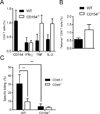Vaccination Produces CD4 T Cells with a Novel CD154-CD40-Dependent Cytolytic Mechanism
- PMID: 26297758
- PMCID: PMC4575887
- DOI: 10.4049/jimmunol.1501118
Vaccination Produces CD4 T Cells with a Novel CD154-CD40-Dependent Cytolytic Mechanism
Abstract
The discovery of new vaccines against infectious diseases and cancer requires the development of novel adjuvants with well-defined activities. The TLR4 agonist adjuvant GLA-SE elicits robust Th1 responses to a variety of vaccine Ags and is in clinical development for both infectious diseases and cancer. We demonstrate that immunization with a recombinant protein Ag and GLA-SE also induces granzyme A expression in CD4 T cells and produces cytolytic cells that can be detected in vivo. Surprisingly, these in vivo CTLs were CD4 T cells, not CD8 T cells, and this cytolytic activity was not dependent on granzyme A/B or perforin. Unlike previously reported CD4 CTLs, the transcription factors Tbet and Eomes were not necessary for their development. CTL activity was also independent of the Fas ligand-Fas, TRAIL-DR5, and canonical death pathways, indicating a novel mechanism of CTL activity. Rather, the in vivo CD4 CTL activity induced by vaccination required T cell expression of CD154 (CD40L) and target cell expression of CD40. Thus, vaccination with a TLR4 agonist adjuvant induces CD4 CTLs, which kill through a previously unknown CD154-dependent mechanism.
Copyright © 2015 by The American Association of Immunologists, Inc.
Figures







References
-
- Lieberman J. The ABCs of granule-mediated cytotoxicity: new weapons in the arsenal. Nat Rev Immunol. 2003;3:361–370. - PubMed
-
- Fleischer B. Acquisition of specific cytotoxic activity by human T4+ T lymphocytes in culture. Nature. 1984;308:365–367. - PubMed
-
- Jellison ER, Kim SK, Welsh RM. Cutting edge: MHC class II-restricted killing in vivo during viral infection. J Immunol. 2005;174:614–618. - PubMed
Publication types
MeSH terms
Substances
Grants and funding
LinkOut - more resources
Full Text Sources
Other Literature Sources
Research Materials
Miscellaneous

